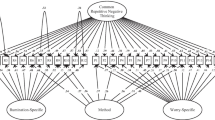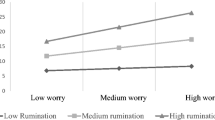Abstract
Repetitive negative thinking (RNT) has been identified as a transdiagnostic construct. However, diagnosis-specific questionnaires have traditionally been used to measure RNT across emotional disorders, and thus the degree to which they assess shared versus unique aspects of RNT is unclear. Furthermore, the degree to which shared versus unique variance across these measures contributes to the prediction of anxiety and depression symptoms is yet to be fully understood. This study had three aims. First, confirmatory factor analysis was used to test the degree to which two common, diagnosis-specific questionnaires assess common versus unique variance in RNT. One questionnaire measured worry whereas the other measured two aspects of rumination (brooding, reflection). Second, the contribution of the shared and unique variance in predicting symptoms of anxiety and depression was determined. Third, the role of shared and unique variance in mediating the relationships between the vulnerability factor of negative affectivity and symptoms of anxiety and depression was assessed. Participants (N = 450) presented for treatment at a specialist clinic with anxiety and affective disorders (54% women). A nested four-factor model (RNT, worry, reflection, brooding) provided a superior fit to two-factor (worry, rumination) and three-factor (worry, reflection, brooding) oblique models. Structural equation modeling showed that RNT, brooding, and worry uniquely predicted anxiety and depression, and reflection also predicted depression. RNT partially mediated the relationship between negative affectivity and anxiety, and brooding partially mediated this relationship for depression and anxiety. Our findings suggest that both RNT and brooding may be separable and transdiagnostic constructs.



Similar content being viewed by others
Notes
The maximum number of cases missing per item was three (0.67%).
References
American Psychiatric Association. (2000). Diagnostic and statistical manual for mental disorders (4th ed., text revision). Washington, DC: Author.
Barlow, D. H. (2002). Anxiety and its disorders: The nature and treatment of anxiety and panic (2nd ed.). New York: Guilford Press.
Beck, A. T., Brown, G., Steer, R. A., Eidelson, J. I., & Riskind, J. H. (1987). Differentiating anxiety and depression: A test of the cognitive content-specificity hypothesis. Journal of Abnormal Psychology, 96, 179–183.
Beck, A. T., Epstein, N., Brown, G., & Steer, R. A. (1988). An inventory for measuring clinical anxiety: Psychometric properties. Journal of Consulting and Clinical Psychology, 56, 893–897.
Beck, A. T., Steer, R. A., & Brown, G. K. (1996). Beck depression inventory-II manual. New York: Harcourt Brace Jovonovich.
Bentler, P. M. (1990). Comparative fit indices in structural models. Psychological Bulletin, 107, 239–246.
Bentler, P. M. (1995). ESQ structural equations program manual. Encino, CA: Multivariate Software.
Borkovec, T. D., Alcaine, O., & Behar, E. (2004). Avoidance theory of worry and generalized anxiety disorder. In R. G. Heimberg, C. L. Turk, & D. S. Mennin (Eds.), Generalized anxiety disorder: Advances in research and practice (pp. 77–108). New York: The Guilford Press.
Borkovec, T. D., Ray, W. J., & Stöber, J. (1998). Worry: A cognitive phenomenon intimately linked to affective, physiological, and interpersonal behavioral processes. Cognitive Therapy and Research, 22, 561–576.
Borkovec, T. D., Robinson, E., Pruzinsky, T., & DePree, J. A. (1983). Preliminary exploration of worry: Some characteristics and processes. Behaviour Research and Therapy, 21, 9–16.
Brown, T. A. (2003). Confirmatory factor analysis of the Penn State Worry Questionnaire: Multiple factors or method effects? Behaviour Research and Therapy, 41, 1411–1426.
Calmes, C. A., & Roberts, J. E. (2007). Repetitive thought and emotional distress: Rumination and worry as prospective predictors of depressive and anxious symptomatology. Cognitive Therapy and Research, 30, 343–356.
Ciesla, J. A., & Roberts, J. E. (2002). Self-directed thought and response to treatment for depression: A preliminary investigation. Journal of Cognitive Psychotherapy: An International Quarterly, 16, 435–453.
Ciesla, J. A., & Roberts, J. E. (2007). Rumination, negative cognitions, and their interactive effects on depressed mood. Emotion, 7, 555–565.
Clark, L. A., & Watson, D. (1991). Tripartite model of anxiety and depression: Psychometric evidence and taxonomic implications. Journal of Abnormal Psychology, 100, 316–336.
Ehring, T., & Watkins, E. R. (2008). Repetitive negative thinking as a transdiagnostic process. International Journal of Cognitive Therapy, 1, 192–205.
Fresco, D. M., Frankel, A. N., Mennin, D. S., Turk, C. L., & Heimberg, R. G. (2002a). Distinct and overlapping features of rumination and worry: The relationship of cognitive production to negative affective states. Cognitive Therapy and Research, 26, 179–188.
Fresco, D. M., Heimberg, R. G., Mennin, D. S., & Turk, C. L. (2002b). Confirmatory factor analysis of the Penn State Worry Questionnaire. Behaviour Research and Therapy, 40, 313–323.
Gignac, G. E. (2007). Multi-factor modeling in individual differences research: Some recommendations and suggestions. Personality and Individual Differences, 42, 37–48.
Goring, H. J., & Papageorgiou, C. (2008). Rumination and worry: Factor analysis of self-report measures in depressed participants. Cognitive Therapy and Research, 32, 554–566.
Grothe, K. B., Dutton, G. R., Jones, G. N., Bodenlos, J., Ancona, M., & Brantley, P. J. (2005). Validation of the Beck Depression Inventory-II in a low income African American sample of medical outpatients. Psychological Assessment, 17, 110–114.
Harvey, A., Watkins, E., Mansell, W., & Shafran, R. (2004). Cognitive behavioural processes across psychological disorders: A transdiagnostic approach to research and treatment. Oxford: Oxford University Press.
Hu, L., & Bentler, P. (1999). Cutoff criteria for fit indices in covariance structure analysis: Conventional versus new alternatives. Structural Equation Modelling, 6, 1–55.
Kojima, M., Furukawa, T. A., Takahashi, H., Kawai, M., Nagay, T., & Tokudome, S. (2002). Cross-cultural validation of the Beck Depression Inventory-II in Japan. Psychiatric Research, 110, 291–299.
Kuyken, W., Watkins, E., Holden, E., White, K., Taylor, R. S., Byford, S., et al. (2010). How does mindfulness-based cognitive therapy work? Behaviour Research and Therapy, 48, 1105–1112.
Lecrubier, Y., Sheehan, D., Weiller, E., Amorim, P., Bonora, I., Harnett-Sheehan, K., et al. (1997). The Mini International Neuropsychiatric Interview (MINI). A short diagnostic structured interview: Reliability and validity according to the CIDI. European Psychiatry, 12, 224–231.
Lo, C. S. L., Ho, S. M. Y., & Hollon, S. D. (2008). The effects of rumination and negative cognitive styles on depression: A meditational analysis. Behaviour Research and Therapy, 46, 487–495.
McEvoy, P. M., Mahoney, A. E. J., & Moulds, M. L. (2010). Are worry, rumination, and post-event processing one and the same? Development of the repetitive thinking questionnaire. Journal of Anxiety Disorders, 24, 509–519.
McIntosh, W. D., & Martin, L. L. (1992). The cybernetics of happiness: The relation of goal attainment, rumination, and affect. Review of Personality and Social Psychology, 14, 222–246.
Meyer, T. J., Miller, M. L., Metzger, R. L., & Borkovec, T. D. (1990). Development and validation of the Penn State worry questionnaire. Behaviour Research and Therapy, 28, 487–495.
Moulds, M. L., Kandris, E., Starr, S., & Wong, A. C. M. (2007). The relationship between rumination, avoidance and depression in a non-clinical sample. Behaviour Research and Therapy, 45, 251–261.
Muris, P., Roelofs, J., Meesters, C., & Boomsma, P. (2004). Rumination and worry in nonclinical adolescents. Cognitive Therapy and Research, 28, 539–554.
Muris, P., Roelofs, J., Rassin, E., Franken, I., & Mayer, B. (2005). Mediating effects of rumination and worry on the links between neuroticism, anxiety and depression. Personality and Individual Differences, 39, 1105–1111.
Nolen-Hoeksema, S. (2000). The role of rumination in depressive disorders and mixed anxiety/depressive symptoms. Journal of Abnormal Psychology, 109, 504–511.
Nolen-Hoeksema, S. (2004). The response styles theory. In C. Papageorgiou & A. Wells (Eds.), Depressive rumination: Nature, theory, and treatment (pp. 107–124). New York: Wiley.
Nolen-Hoeksema, S., & Morrow, J. (1991). A prospective study of depression and posttraumatic stress symptoms after a natural disaster: The 1989 Loma Prieta earthquake. Journal of Personaltiy and Social Psychology, 61, 115–121.
Nolen-Hoeksema, S., & Morrow, J. (1993). Effects of rumination and distraction on naturally occurring depressed mood. Cognition and Emotion, 7, 561–570.
Nolen-Hoeksema, S., Wisco, B. E., & Lyubomirsky, S. (2008). Rethinking rumination. Perspectives on Psychological Science, 3, 400–424.
Peterson, R. A., & Plehn, K. (1999). Measuring Anxiety Sensitivity. In S. Taylor (Ed.), Anxiety sensitivity: Theory, research, and treatment in the fear of anxiety (pp. 61–81). Mahwah, NJ: Lawrence Erlbaum Associates.
Peterson, R. A., & Reiss, S. (1987). Anxiety sensitivity index manual. Worthington, OH: International Diagnostic Systems.
Peterson, R. A., & Reiss, S. (1992). Anxiety sensitivity index manual. Worthington, OH: International Diagnostic Systems.
Roy-Byrne, P. P., Craske, M. G., Stein, M. B., Sullivan, G., Bystritsky, A., Katon, W., et al. (2005). A randomized effectiveness trial of cognitive-behavioral therapy and medication for primary care panic disorder. Archives of General Psychiatry, 62, 290–298.
Schmidt, N. B., Zvolensky, M. J., & Maner, J. K. (2006). Anxiety sensitivity: Prospective prediction of panic attacks and Axis I pathology. Journal of Psychiatric Research, 40, 691–699.
Segal, Z. V., Williams, J. M. G., & Teasdale, J. D. (2002). Mindfulness-based cognitive therapy for depression: A new approach to preventing relapse. New York: The Guilford Press.
Segerstrom, S. C., Tsao, J. C. I., Alden, L. E., & Craske, M. G. (2000). Worry and rumination: Repetitive thought as a concomitant and predictor of negative mood. Cognitive Therapy and Research, 24, 671–688.
Sheehan, D. V., Lecrubier, Y., Sheehan, K. H., Amorim, P., Janavs, J., Weiller, E., et al. (1998). The Mini-International Neuropsychiatric Interview (M.I.N.I.): The development and validation of a structured diagnostic psychiatric interview for DSM-IV and ICD-10. Journal of Clinical Psychiatry, 59((suppl. 20)), 22–33.
Sheehan, D. V., Lecrubier, Y., Sheehan, K. H., Janavs, J., Weiller, E., Keskiner, A., et al. (1997a). The Mini International Neuropsychiatric Interview (MINI). A short diagnostic structured interview: Reliability and validity according to the CIDI. European Psychiatry, 12, 224–231.
Sheehan, D. V., Lecrubier, Y., Sheehan, K. H., Janavs, J., Weiller, E., Keskiner, A., et al. (1997b). The validity of the Mini International Neuropsychiatric Interview (MINI) according to the SCID-P and its reliability. European Psychiatry, 12, 232–241.
Sobel, M. E. (1982). Asymptotic confidence intervals for indirect effects in structural equation models. Sociological Methodology, 13, 290–312.
Sprinkle, S. D., Lurie, D., Insko, S. L., Atkinson, G., Jones, G. L., Logan, A. R., et al. (2002). Criterion validity, severity cut scores, and test-retest reliability of the Beck Depression Inventory–II in a University Counseling Center Sample. Journal of Counseling Psychology, 49, 381–385.
Steiger, J. H. (1990). Structure model evaluation and modification: An interval estimation approach. Multivariate Behavioral Research, 25, 173–180.
Steiger, J. H., Shapiro, A., & Browne, M. W. (1985). On the multivariate asymptotic distribution of sequential Chi-square statistics. Psychometrika, 50, 253–264.
Tabachnick, B. G., & Fidell, L. S. (2001). Using multivariate statistics. Boston: Allyn & Bacon.
Treynor, W., Gonzalez, R., & Nolen-Hoeksema, S. (2003). Rumination reconsidered: A psychometric analysis. Cognitive Therapy and Research, 27, 247–259.
Tucker, L. R., & Lewis, C. (1973). A reliability coefficient for maximum likelihood factor analysis. Psychometrika, 38, 1–10.
Watkins, E. R. (2008). Constructive and unconstructive repetitive thought. Psychological Bulletin, 134, 163–206.
Watkins, E. R. (2009). Depressive rumination: Investigating mechanisms to improve cognitive behavioural treatments. Cognitive Behaviour Therapy, 38, 8–14.
Watkins, E., & Moulds, M. (2005). Distinct modes of ruminative self-focus: Impact of abstract versus concrete rumination on problem solving in depression. Emotion, 5, 319–328.
Watson, D., & Clark, L. A. (1984). Negative affectivity: The disposition to experience aversive emotional states. Psychological Bulletin, 96, 465–490.
Watson, D., Clark, L. A., & Tellegen, A. (1988). Development and validation of brief measures of positive and negative affect: The PANAS scale. Journal of Personality and Social Psychology, 54, 1063–1070.
Author information
Authors and Affiliations
Corresponding author
Rights and permissions
About this article
Cite this article
McEvoy, P.M., Brans, S. Common Versus Unique Variance Across Measures of Worry and Rumination: Predictive Utility and Mediational Models for Anxiety and Depression. Cogn Ther Res 37, 183–196 (2013). https://doi.org/10.1007/s10608-012-9448-5
Published:
Issue Date:
DOI: https://doi.org/10.1007/s10608-012-9448-5




